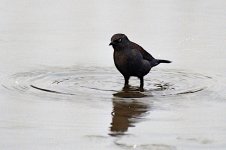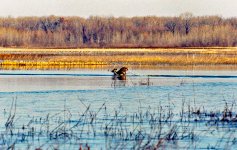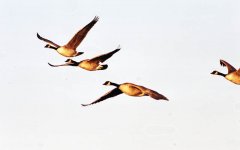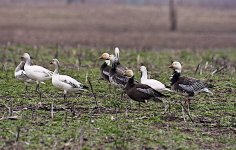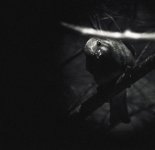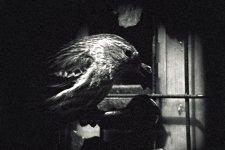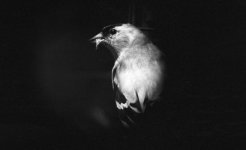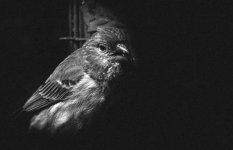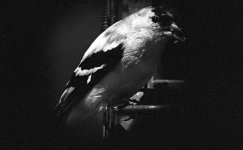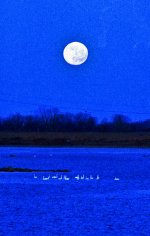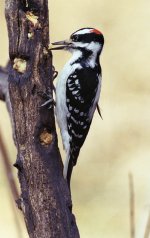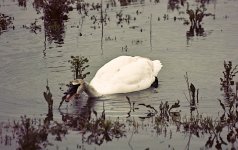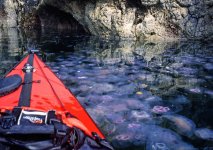-
Welcome to BirdForum, the internet's largest birding community with thousands of members from all over the world. The forums are dedicated to wild birds, birding, binoculars and equipment and all that goes with it.
Please register for an account to take part in the discussions in the forum, post your pictures in the gallery and more.
You are using an out of date browser. It may not display this or other websites correctly.
You should upgrade or use an alternative browser.
You should upgrade or use an alternative browser.
Vintage and Classic Film Cameras (1 Viewer)
- Thread starter 42za
- Start date
More options
Who Replied?SimonLS
Well-known member

I've always been fascinated by cameras - from seeing my dad's old bellows camera to the cutaways of SLRs I used to look at in a department store window as a child.
I got my first proper camera when I was 14, a Praktica Super TL1000 with 50mm and 135mm lenses. With that I taught myself about composition, exposure and depth of field. If I can find it I'll post a picture.
For my 18th birthday I was given my first Nikon, an F301. After this I went on to buy an FA and an FE2. All are still in full working order over 30 years later.
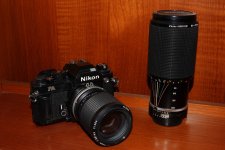
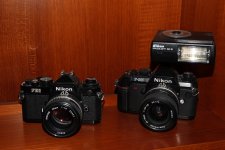
I got my first proper camera when I was 14, a Praktica Super TL1000 with 50mm and 135mm lenses. With that I taught myself about composition, exposure and depth of field. If I can find it I'll post a picture.
For my 18th birthday I was given my first Nikon, an F301. After this I went on to buy an FA and an FE2. All are still in full working order over 30 years later.


Last edited:
Bird_Bill
Well-known member
Hi 42!
Hope as is well with you and everyone during these times
Yes!...rediscovered film, my film stock stuck way in back inside my fridge last October, while cleaning.
17 rolls of various makes and speeds, from fujichrome 25 to Tri-X 400
Since, added more film in December, and have been shooting film almost exclusively for the past 6 months or so.
I'm digitally burnt out, and desperately needed the thoughtful break film gives us
Dusted off a Pentax LX, and a Pentax ZX-L, 35mm film bodies
Mamiya 330S 6cm square medium format body, and boat anchor...its a robust build.
Here's one from the LX, and pentax A 400 f/5.6 on Kodak UltraMax 400
a couple weeks ago. Processed in kodak flexicolor C-41 chemicals, that I also laid into last December. Scanned using an Epson V550
Rusty Blackbird (Euphagus carolinus)
Hope as is well with you and everyone during these times
Yes!...rediscovered film, my film stock stuck way in back inside my fridge last October, while cleaning.
17 rolls of various makes and speeds, from fujichrome 25 to Tri-X 400
Since, added more film in December, and have been shooting film almost exclusively for the past 6 months or so.
I'm digitally burnt out, and desperately needed the thoughtful break film gives us
Dusted off a Pentax LX, and a Pentax ZX-L, 35mm film bodies
Mamiya 330S 6cm square medium format body, and boat anchor...its a robust build.
Here's one from the LX, and pentax A 400 f/5.6 on Kodak UltraMax 400
a couple weeks ago. Processed in kodak flexicolor C-41 chemicals, that I also laid into last December. Scanned using an Epson V550
Rusty Blackbird (Euphagus carolinus)
Attachments
Hello All,
Thanks for the replies.
Here are pictures of 2 of my film cameras.
The Nikon FM2n is my favourite , at the moment I am using 2 Nikkor lenses with it , the standard 50mm f1.8 and a 28mm f2.8 , the camera still works as well as the day it was built.
The Leidolf Lordomat C35 Range Finder camera (made in Wetzlar Germany) dates from 1956 and is a solid very well built camera , it carries the 50mm Lordonor f2.8 lens.
The Selenium meter has died of old age , but the camera is otherwise in excellent working order.
I have more but will have to take pictures of them.
Cheers.



Thanks for the replies.
Here are pictures of 2 of my film cameras.
The Nikon FM2n is my favourite , at the moment I am using 2 Nikkor lenses with it , the standard 50mm f1.8 and a 28mm f2.8 , the camera still works as well as the day it was built.
The Leidolf Lordomat C35 Range Finder camera (made in Wetzlar Germany) dates from 1956 and is a solid very well built camera , it carries the 50mm Lordonor f2.8 lens.
The Selenium meter has died of old age , but the camera is otherwise in excellent working order.
I have more but will have to take pictures of them.
Cheers.



...have been shooting film almost exclusively for the past 6 months or so.
I'm digitally burnt out, and desperately needed the thoughtful break film gives us
Hats off to you sir. Do you focus on wildlife photography, or are you using film for general photography as well? Are you using autofocus lenses, or manual?
There will doubtless be some nice photos of classic cameras posted in this thread, but photos taken by those cameras would be of infinitely more interest (to me, anyway).
Bird_Bill
Well-known member
Hats off to you sir. Do you focus on wildlife photography, or are you using film for general photography as well? Are you using autofocus lenses, or manual?
There will doubtless be some nice photos of classic cameras posted in this thread, but photos taken by those cameras would be of infinitely more interest (to me, anyway).
Hi Patudo!
Cheers! and thank you.
I again almost exclusively use manual focus lenses on my film bodies.
Either using a 3 field focus screen or a matte screen.
One autofocus body I have, incorporates what's called "catch in focus"
That's a proprietary focus priority mode that releases the shutter on a focus confirmation. It's meant for manual focus lenses. I suppose it eased the transition into autofocus for people.
Light!....that's what we chase, and it moves at the speed of light.
Presetting and anticipating is critical
For me, easier said than done.
I'd love to hear and learn from others on their own techniques.
Using the same 400mm f/5.6 and LX as in the black bird shot
Caught this buck chasing his harem of does last fall.
Used aperture priority and f/8, focused close to infinity.
it threw me a shutter speed of 1/1000 on kodak gold 200
At hyperfocal that's what shows.
The second shot, using the same 400mm on an autofocus body using the catch in focus function. I tweaked the focus helicoid as the geese came into me, the shutter released on focus confirmation. On kodak gold 200 also.
Third shot, again using the focus trap with the autofocus body, and a manual focus 600mm ED f/5.6. On kodak portra 400...I like that film a lot.
Attachments
Hats off to you sir. Do you focus on wildlife photography, or are you using film for general photography as well? Are you using autofocus lenses, or manual?
There will doubtless be some nice photos of classic cameras posted in this thread, but photos taken by those cameras would be of infinitely more interest (to me, anyway).
Hello Patudo,
Ok here is a random test photo that I took with my Nikon FM2n.
I am not able to post a bird photo as I do not have any long focus lenses for the FM2n.
I hope that the moderators will understand.
The photo was taken on Fujicolor C200 , developed and scanned by my local photo laboratory.
I have lost the exposure details.
Absolutely NO post processing or "photoshopping" has been done.

Cheers.
Cheers

This is an interesting topic....I shoot film with various cameras but always street photography. I don't have long range lens for birding or nature. But a thought as this is a challenge. As Bird-Bill says..."he is 'digitally burnt out' and desperately needed the thoughtful break film gives us." Nice quote.
I like the looks of many of the photo's that have been posted by Bird-Bill...classic to say the least. Film slows a person down and while the image is not crisp and sharp, it has an air of quality to it.
I am reading a book about Book of Birds by the National Geographic Society published in 1939 and the photos are grainy, not sharp etc (just like Bird-Bill) but again, have that feeling that someone took the time to shoot these images. IT is not easy, and you have to carefully think of how to set up 'not just yourself' but the camera as well. It SLOWS you down and puts you back in some human world instead of this digital one we live in.
Now...as a suggestion....the same 'slowing down' is what digi-scoping does too. Granted it is still digital but the process of slowing down, thinking....taking your time to set up the shot etc is much the same.
I wonder what digital-scoping with film might look like, eh? .....might give it a shot here. Nice forum topic!!! jim
I like the looks of many of the photo's that have been posted by Bird-Bill...classic to say the least. Film slows a person down and while the image is not crisp and sharp, it has an air of quality to it.
I am reading a book about Book of Birds by the National Geographic Society published in 1939 and the photos are grainy, not sharp etc (just like Bird-Bill) but again, have that feeling that someone took the time to shoot these images. IT is not easy, and you have to carefully think of how to set up 'not just yourself' but the camera as well. It SLOWS you down and puts you back in some human world instead of this digital one we live in.
Now...as a suggestion....the same 'slowing down' is what digi-scoping does too. Granted it is still digital but the process of slowing down, thinking....taking your time to set up the shot etc is much the same.
I wonder what digital-scoping with film might look like, eh? .....might give it a shot here. Nice forum topic!!! jim

A few shots
I decided to try this out.... I took my Swarovski Scope and hand held my Film Minolta SRT Camera using Kodak TriX 400 BW film. I shot at 5.6 with a shutter of 500. It was interesting. I focused using the scope, and drew up the camera to the eyepiece. It was not easy getting the camera aligned to the eye-piece as I had to look thru the viewfinder and shift camera accordingly. No back screen as in digital camera to help myself compose the shot.
Also, ....this set-up produced dark images as you can see. Kind of eerie in a way. The background is all blacked out and the light (although somewhat sunny out today) wasn't enough to really produce shots that had the background lit up. Anyhow, an experiment....I really don't mind the shots.
Next time I will have to use color film but I didn't have any in the freezer! ....
I decided to try this out.... I took my Swarovski Scope and hand held my Film Minolta SRT Camera using Kodak TriX 400 BW film. I shot at 5.6 with a shutter of 500. It was interesting. I focused using the scope, and drew up the camera to the eyepiece. It was not easy getting the camera aligned to the eye-piece as I had to look thru the viewfinder and shift camera accordingly. No back screen as in digital camera to help myself compose the shot.
Also, ....this set-up produced dark images as you can see. Kind of eerie in a way. The background is all blacked out and the light (although somewhat sunny out today) wasn't enough to really produce shots that had the background lit up. Anyhow, an experiment....I really don't mind the shots.
Next time I will have to use color film but I didn't have any in the freezer! ....
Attachments
I decided to try this out.... I took my Swarovski Scope and hand held my Film Minolta SRT Camera using Kodak TriX 400 BW film. I shot at 5.6 with a shutter of 500. It was interesting. I focused using the scope, and drew up the camera to the eyepiece. It was not easy getting the camera aligned to the eye-piece as I had to look thru the viewfinder and shift camera accordingly. No back screen as in digital camera to help myself compose the shot.
Also, ....this set-up produced dark images as you can see. Kind of eerie in a way. The background is all blacked out and the light (although somewhat sunny out today) wasn't enough to really produce shots that had the background lit up. Anyhow, an experiment....I really don't mind the shots.
Next time I will have to use color film but I didn't have any in the freezer! ....
Hello there,
Interesting experiment , nice "moody" photo's.
I have not been able to find TriX for years and years , Ilford B&W films are freely available however |
Cheers.
Bird_Bill
Well-known member
I decided to try this out....
Hi Jim
Looks promising!
Those are the first "film-o-scoped images I've ever seen...birds shot through a scope and captured on an analog film emulsion.
Half the fun of getting the film image is getting there to get the image in the first place.
Few more from the past few months. I do post process, given no choice. First, I home scan into TIFF format where there is some data compression. A 35mm film format scan produces a TIFF file of app. 70mb. Much too large to uplaod. TIFF's are converted to JPEG's, and much smaller, more reasonable sizes. By doing that, I'm again post processing. Labs do it to us unknowingly.
Labs batch process test strips in their chemistry, then use those test strips to calibrate their scanners. Converting to JPEG algorithms is post processing.
1-Kodak UltraMax 400 thru a pentax A 35mm to 105mm f/3.5 zoom on an LX body. Dec 12 2019 full moon over trumpeter swans about 25 minutes after sunset. I knew the blue spectrum would predominate. Zoomed into 105mm
2-Kodak UltraMax 400 thru a pentax A* 200mm ED f/4 macro on an LX.
male Hairy woodpecker (Leuconotopicus villosus) taking walnut chips from an old oak branch that fell. I drilled holes into the dead branch and use it as a walnut chip feeder. Woodpeckers, titmice, chickadees, wrens...other species favor walnuts over suet. Have the two out, and walnuts are always taken first. Image is post processed via TIFF scan to JPEG conversion.
Attachments

two shots and why good
These are good pictures with texture. To me, 'getting the picture' and the skill needed to take an image using film is what makes film so unique. The photographer needs to take their time and slow down, to observe the situation. So with the swan shot, a person coming in with digital and $$$$ lens, will raise the ISO to 30,000 and shoot a billion shots in a five minute timespan. But with film, you wait...... you might even have to return the next day as the sun sets and you find the perfect time. (Of course birds might not be there~). Point is, you use some skill to take the shot.
So nicely done.....I like your idea with the walnuts over suet. The nice part is that the walnut or whatever, is embedded in the tree so your shot isn't that of a suet cage or a bird feeder but 'nature'..... That is key to a good photograph of birds. Steer away from man-made objects if you can. jim.
Hi Jim
Looks promising!
Those are the first "film-o-scoped images I've ever seen...birds shot through a scope and captured on an analog film emulsion.
Half the fun of getting the film image is getting there to get the image in the first place.
Few more from the past few months. I do post process, given no choice. First, I home scan into TIFF format where there is some data compression. A 35mm film format scan produces a TIFF file of app. 70mb. Much too large to uplaod. TIFF's are converted to JPEG's, and much smaller, more reasonable sizes. By doing that, I'm again post processing. Labs do it to us unknowingly.
Labs batch process test strips in their chemistry, then use those test strips to calibrate their scanners. Converting to JPEG algorithms is post processing.
1-Kodak UltraMax 400 thru a pentax A 35mm to 105mm f/3.5 zoom on an LX body. Dec 12 2019 full moon over trumpeter swans about 25 minutes after sunset. I knew the blue spectrum would predominate. Zoomed into 105mm
2-Kodak UltraMax 400 thru a pentax A* 200mm ED f/4 macro on an LX.
male Hairy woodpecker (Leuconotopicus villosus) taking walnut chips from an old oak branch that fell. I drilled holes into the dead branch and use it as a walnut chip feeder. Woodpeckers, titmice, chickadees, wrens...other species favor walnuts over suet. Have the two out, and walnuts are always taken first. Image is post processed via TIFF scan to JPEG conversion.
These are good pictures with texture. To me, 'getting the picture' and the skill needed to take an image using film is what makes film so unique. The photographer needs to take their time and slow down, to observe the situation. So with the swan shot, a person coming in with digital and $$$$ lens, will raise the ISO to 30,000 and shoot a billion shots in a five minute timespan. But with film, you wait...... you might even have to return the next day as the sun sets and you find the perfect time. (Of course birds might not be there~). Point is, you use some skill to take the shot.
So nicely done.....I like your idea with the walnuts over suet. The nice part is that the walnut or whatever, is embedded in the tree so your shot isn't that of a suet cage or a bird feeder but 'nature'..... That is key to a good photograph of birds. Steer away from man-made objects if you can. jim.

Hello there,
Interesting experiment , nice "moody" photo's.
I have not been able to find TriX for years and years , Ilford B&W films are freely available however |||
||
|.
Cheers.
I know it depends on where you live and what is available.... TriX really common here in the states in camera stores, ....not just stores but camera stores (B and H etc)....
Best of luck, I hope you fine some. Thanks on the 'moody shots' comment as yes, I agree, jim
Bird_Bill
Well-known member
My latest batch and effort.
Kodak Ektar 100, through a 600mm ED f/5.6...f/5.6 @ 1/60
Processed in kodak flexicolor C-41 chemistry...developer...3:15 @ 38c
Scanned on an epson V550
Trumpeter swan (Cygnus buccinator)
Getting uppity with two Canada geese between it and I
Very dark day, 10EV perhaps.
Used my youngest film body, pentax ZX-L....no mirror lock up...but dampening of the mirror and shutter is very soft. I was laying on the ground cradling that 600.
Kodak Ektar 100, through a 600mm ED f/5.6...f/5.6 @ 1/60
Processed in kodak flexicolor C-41 chemistry...developer...3:15 @ 38c
Scanned on an epson V550
Trumpeter swan (Cygnus buccinator)
Getting uppity with two Canada geese between it and I
Very dark day, 10EV perhaps.
Used my youngest film body, pentax ZX-L....no mirror lock up...but dampening of the mirror and shutter is very soft. I was laying on the ground cradling that 600.
Attachments

Definitely has that 'film' feel to it....it should as it was film! But to me, these photos remind me so much of some old bird books I have. It was a true skill to capture birds using the lens and cameras of old days. Well done. I think your examples etc, show that not everything has to be tack sharp....perfect. No reason. The mood and flavor or film over-ride sharpness.
I have some all ready to develop up but in BW. I am going to get some color film as you suggested. Keep shooting now. ...
I have some all ready to develop up but in BW. I am going to get some color film as you suggested. Keep shooting now. ...
Andrea Collins
Well-known member

I used Olympus SLRs for taking photos in the mountains from the 1980s until the mid 2000s. I had an OM1 and later an OM2n. After many years of abuse in fairly tough environments both finally died and were disposed of in favour of DSLRs.
In 2004 I bought a Nikonos V for using when seakayaking. I only actually used it for a couple of years before going digital, using the Canon Powershot series in underwater housings designed for diving. I still have the Nikonos for odd sentimental reasons. Occasionally I get it out and have a mess about with it. I like the very simple and chunky controls but I would never want to go back to film again. I don't find that using digital cameras makes me lazy.
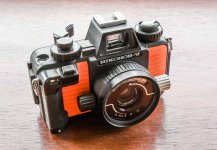
In 2004 I bought a Nikonos V for using when seakayaking. I only actually used it for a couple of years before going digital, using the Canon Powershot series in underwater housings designed for diving. I still have the Nikonos for odd sentimental reasons. Occasionally I get it out and have a mess about with it. I like the very simple and chunky controls but I would never want to go back to film again. I don't find that using digital cameras makes me lazy.

Andrea Collins
Well-known member


Since I only had the 35mm lens for the Nikonos I didn't exactly take many wildlife photos with it. This was taken on the west coast of the Isle of Skye on a very gloomy day showing a mass of Moon Jellyfish trapped in an inlet below steep cliffs. No idea what film I would have been using.
View attachment 724901
Very abstract like....I like the image!
Chosun Juan
Given to Fly

I used to have an old Zenit-E (I think - it was the silver aluminium bodied model) that I inherited.
It had that wonderful exposure sensor and needle and eyelet meter which taught me the basics of photography when I was a teen. I used to really like fiddling with all the settings to line everything up ..... but of course such an involved manual process meant many things moved off before you were ready !
It was a reassuringly solid bit of kit and came with 35mm or 50mm prime or something (I can't remember) , a 135mm or 180mm telephoto (again can't remember) , flash unit, and cutout foam lined case - it all felt very professional.
It came to grief a bit when the screw fitting into the camera base from the leather holder and neck strap came loose - first I knew about it was the whole lot plummeting onto the road when I bent forward to photograph a Quokka - who luckily escaped unharmed ! Everything continued to work to perfection though there was a big dent in the rim of the lens !
I might have photos taken with it tucked away somewhere - maybe ?
I ended up trading the whole system in on an auto-focus Minolta 700Si film camera ..... a few shots taken with it are in my gallery.
Good times. :t:
Chosun :gh:
It had that wonderful exposure sensor and needle and eyelet meter which taught me the basics of photography when I was a teen. I used to really like fiddling with all the settings to line everything up ..... but of course such an involved manual process meant many things moved off before you were ready !
It was a reassuringly solid bit of kit and came with 35mm or 50mm prime or something (I can't remember) , a 135mm or 180mm telephoto (again can't remember) , flash unit, and cutout foam lined case - it all felt very professional.
It came to grief a bit when the screw fitting into the camera base from the leather holder and neck strap came loose - first I knew about it was the whole lot plummeting onto the road when I bent forward to photograph a Quokka - who luckily escaped unharmed ! Everything continued to work to perfection though there was a big dent in the rim of the lens !
I might have photos taken with it tucked away somewhere - maybe ?
I ended up trading the whole system in on an auto-focus Minolta 700Si film camera ..... a few shots taken with it are in my gallery.
Good times. :t:
Chosun :gh:
Users who are viewing this thread
Total: 2 (members: 0, guests: 2)




